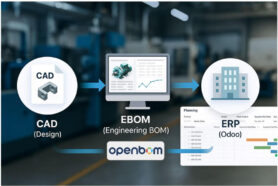
In today’s fast-paced digital landscape, where data becomes a new oil, the concept of a Single Source of Truth (SSOT) has become increasingly crucial for engineering teams and manufacturing companies. But what exactly does SSOT mean in this modern era, and how can companies effectively implement it amidst evolving technologies and paradigms?
In a recent exploration of preparing for Product Lifecycle Management (PLM) implementation, I shared my thoughts about the significance of establishing data integrity, striving for a single source of truth, and optimizing information flow. Check my article – A 3-Step Guide To Resolve Data Challenges Before PLM Implementation. Following that discussion, a few people reached out to me to ask about single source truth. The concept of SSOT is simple and complex at the same time. Therefore, in my article today, I decided to share more information about what is a single source of truth and how to apply it in a modern digital environment.
The Genesis of SSOT:
The origins of SSOT trace back 15 to 20 years, stemming from the simple yet profound idea that all organizational information should reside in a unified repository to mitigate confusion and redundancy. Initially, this translated into selecting a single system or database as the designated SSOT. However, the implementation of this concept encountered hurdles due to its rigidity and detachment from reality.
Challenges in Implementation:
While the concept of a centralized data repository seemed promising, its execution faltered in practicality. Many engineering and manufacturing companies predominantly dealt with files, such as CAD designs and simulations, which posed a challenge to the traditional SSOT model.
In the real world, most of the companies in the engineering and manufacturing space were working with files (eg. CAD, simulation, etc). The idea of a single source of truth was to put all these files in a single “vault”, add some metadata, and lock everyone to a single system. The reality is that not all people were able to connect to this single “vault/database” and at the same time, many users needed a “fragment” of data (eg. part list for purchasing, vendor quotes, requirements documents, etc.)
Evolution in Data Management:
The last decade of Software as a Service (SaaS) and cloud-based systems revolutionized the data management landscape. Companies shifted their focus from managing documents to sharing data, transcending the limitations of file attachments in emails. Although this transition remains ongoing, it has triggered a paradigm shift in how organizations approach data management.
Distributed SSOT in the Digital Era:
Today, the essence of SSOT transcends the confines of a singular system or database. Instead, it embodies an integrated information ecosystem, wherein data is stored, modified, and shared across multiple applications and services.
Here is what we see happening these days in engineering and manufacturing companies and how to apply the idea of SSOT. The Single Source of Truth is not a system or database. It is a single source of truth, not an application. It is a concept of having an integrated information set and a decision about how data is stored, changed, and shared. Multiple applications including OpenBOM can help you to organize it, but it can also be part of other applications and services to manage and share the data. By setting an integrated data set, you set three things – (1) data locations/service; (2) ownership and master data status; and (3) rules on how data can be changed and updated between services.
Tools like OpenBOM offer invaluable assistance in organizing this distributed data landscape, but SSOT can manifest within various platforms tailored to a company’s unique requirements. By establishing an integrated dataset, companies delineate data locations, ownership, master data status, and protocols for data modification and updates across different services.
How OpenBOM helps you to organize your single source of truth
OpenBOM serves as a critical tool in navigating the complexities of data organization within the framework of a Single Source of Truth (SSOT). It includes 3 important components:
Flexible Data Model:
OpenBOM boasts a flexible data model that empowers users to create a diverse array of objects tailored to manage different types of information. This versatility allows organizations to structure their data according to specific needs, whether it’s managing parts and assemblies, tracking inventory, or documenting requirements. By accommodating various data structures within a unified platform, OpenBOM facilitates the aggregation of disparate information into a coherent and manageable dataset, thereby contributing to the establishment of an SSOT.
Seamless Integration with Different Systems:
One of the hallmark features of OpenBOM is its seamless integration capabilities with a multitude of systems and applications. This integration prowess enables organizations to define and enforce rules governing the transfer and updating of data across disparate systems. Whether it’s synchronizing data between PLM, ERP, CAD, or other software solutions, OpenBOM facilitates the seamless flow of information, ensuring data consistency and accuracy throughout the organization. By fostering interoperability between diverse systems, OpenBOM plays a crucial role in maintaining the integrity of the SSOT.
Live Links between Information Islands:
In the era of distributed data networks, OpenBOM shines by establishing live links between various information islands scattered across different applications and services. Rather than attempting to centralize all data within a singular database or vault, OpenBOM fosters connectivity between disparate sources, creating a dynamic network of data and applications. This interconnected ecosystem allows users to access and manipulate data in real-time, fostering collaboration and agility across the organization. By embracing a distributed approach to data management, OpenBOM transcends the limitations of traditional SSOT models, enabling organizations to harness the full potential of their data assets.
Conclusion:
In the modern digital environment, the definition of SSOT has evolved from a rigid database or file vault to an agile and interconnected network of applications and services. This distributed approach empowers organizations to manage information effectively while adhering to controlled processes for data manipulation. As we navigate this dynamic environment, embracing the concept of SSOT is critical for enhancing operational efficiency and driving informed decision-making.
Embrace the evolution of data management and embark on your journey towards a unified information ecosystem. Register for free to explore the capabilities of OpenBOM today.
Best regards,
Oleg
Join our newsletter to receive a weekly portion of news, articles, and tips about OpenBOM and our community.











